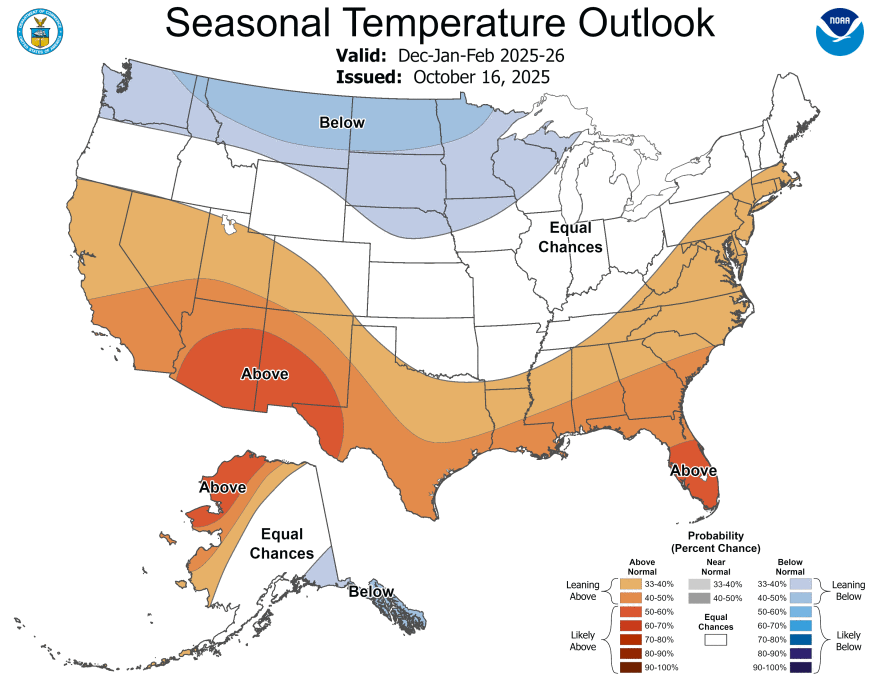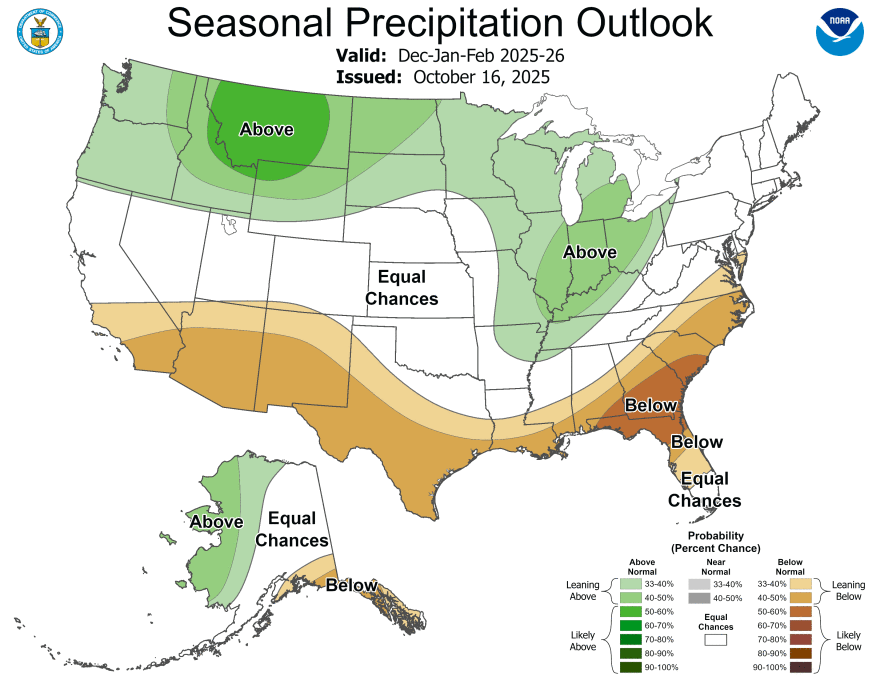The Northwoods, some parts more than others, got its first taste of winter last weekend.
After two back-to-back low snow years, many are anxiously awaiting to see what this winter has in store.
NOAA's Climate Prediction Center is calling for a winter that’s more like what we’re used to seeing in the Northwoods.
The center released its first winter report last month.
Winter Outlook Report
Amanada Latham is an Outreach Specialist with the Wisconsin State Climatology Office. She says that report shows northern Wisconsin having about a 30 to 40 percent chance of a cooler and wetter than average winter.

“That would likely mean snow. But of course, that can also be a little bit of a sleety rain mix. It just depends on the temperatures,” said Latham.
Latham the biggest influence on winter is if we’re in a La Niña or El Niño weather pattern.
“When we're talking about those two phenomena, or those two patterns, we're looking at water temperatures in the Pacific Ocean near the equator,” said Latham. “Even though it's so far away from the US, it's kind of a ripple effect, a small change there has big changes, really, throughout the region and throughout the globe.”
The winter of 2023-2024, the one where the Northwoods saw little snow, was an El Niño winter.
This year, climatologists are expecting a weak La Niña to impact our winter. In past years, this weather pattern has produced snowier winters for the Northwoods.
“The last weak La Niña winter in Wisconsin was 2022 to 2023 and, specifically, Rhinelander got close to 60 inches of snow, which was the city's fourth snowiest winter in the last 30 years,” said Latham. “That winter was also a little bit warmer than average up in northern Wisconsin. So typically, even if it is a weaker impact, that can lead to slightly snowier conditions, but also possibly a little bit milder.”

As climatologist and meteorologists look to weather patterns like La Niña and what it has meant for past winters to forecast, a local wildlife rehabilitator has come to rely on the animals he treats.
‘Just those wild instincts’
Mark Naniot is the Rehabilitation Director for Wild Instincts.
In the decades he’s been working with wildlife, he’s come to learn from them how severe the winter is looking.
This can range from changes in migrations, the amounts of berries and nuts still being produced, or the amount of fat on animals.
“Sometimes we see where the animals are normally having their young [later], like second baby squirrel season normally starts about the first part of August or so. Sometimes we've seen it start the first part of September,” said Naniot.
When asked how the animals can know what’s coming in the months ahead, Naniot says it all comes down to those wild instincts.
“For whatever reason, they know much better than what we do, and so they act accordingly,” said Naniot. “That's why we named our facility wild instincts, because the animals just have these incredible instincts that we'll never be able to understand.”
WXPR interviewed Naniot the last two falls.

In 2023, Naniot was still seeing active bears later than usual and fawns born in September.
He told WXPR then he was expecting a delayed winter, and, of course, that year it was so delayed we didn’t really have one.
And then last year, Naniot was once again seeing things slower and later with animals, he was ready for a pretty mild winter.
Which again, last winter, while we got some snow, it was definitely not what we’re used to in the Northwoods.
So, what’s Naniot seeing this year?
“Still kind of mixed signals,” said Naniot.
Normally, by August or September, Naniot would have a good idea of what winter is going to be like, and while it’s not as clear this year, he doesn’t think it’s going to be too harsh.
“I would say it's probably, the way things are looking, going to be kind of a medium type of winter, not super heavy, but still going to be a little bit more than what we've had the last couple of years, by what I'm seeing for animal signs,” said Naniot. “But, things are a little mixed this year, so I think it's still going to be a little bit late and probably not quite as intense as some of the bad winters that we've had.”
Farmer’s Almanac
The Farmer’s Almanac extended forecast is calling for a very cold, snowy winter for the Midwest.
It’s been predicting seasonal outlooks since 1818, though it announced recently that the 2026 edition will be its last.
That one is not to be confused with the Old Farmer’s Almanac which will still be publishing as it has since 1792. Its winter weather forecast is calling for a “mild winter by local standards with some snowy bursts” for the Upper Midwest.
Climate Change
While the Northwoods looks forward to getting back to more normal winters, Latham says the state is experiencing the impacts of climate change.
One of the biggest changes has been in the overnight lows.
“A lot of places aren't falling below freezing as much as they used to. A lot of places not seeing subzero temperatures as much as they used to,” said Latham. “In fact, our coldest conditions of winter are starting to get not as cold. So those extremes aren't getting quite as extreme as they used to.”
This can impact things like lake health and creating more heavy, wet snow.
Latham reminds people that climate looks at weather over a 30-year or more period to see if things like our recent low-snow winters are an outlier or a trend.




